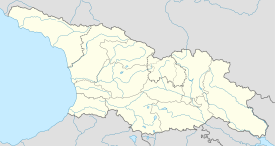| Bolnisi Sioni ბოლნისის სიონი | |
|---|---|
 Bolnisi Sioni Cathedral | |
| Religion | |
| Affiliation | Georgian Orthodox Church |
| Location | |
| Location | Bolnisi, Kvemo Kartli Province ( Mkhare), Georgia |
| Geographic coordinates | 41°23′20″N 44°30′45″E / 41.388889°N 44.5125°E |
| Architecture | |
| Style | Georgian |
| Completed | 478–493 |
Bolnisi Sioni ( Georgian: ბოლნისის სიონი) or Bolnisi Sioni Cathedral is a Georgian Orthodox basilica in the Bolnisi village of Bolnisi District, Georgia. The cathedral was built in 478–493. It is the oldest extant church building in Georgia. [1] Bishop David was the overseeing church leader for the construction of Bolnisi Sioni.[ citation needed]
Bolnisi Sioni Cathedral is known for its Georgian inscriptions. These are one of the oldest historical documents of the Georgian alphabet. This church is the first Georgian building to have a completion date on the exterior. Bolnisi Sioni’s decorative scheme was a Sasanian style. The southern and central parts of the church are adorned with curling vine scrolls, arabesques, and foliate motifs. Uniform masonry blocks were used to build on to the original building’s late antiquity remnants on the southern façade.[ citation needed]
The country of Georgia was in contact with Persia during the time of Bolnisi Sioni’s construction. [2] Evidence of this is in the decoration of the building. The sculpture and embellishments of Bolnisi Sioni and other surrounding Georgian churches are influenced from Iranian, Armenian, and Near Eastern art and architecture. [3] The hunting depictions and sculpture are similar to Iranian 4th and 5th century art and architecture.[ citation needed]
-
Bolnisi Sioni bell-tower.
-
Church façade and exterior portal.
-
Early inscription
-
Interior of Bolnisi Sioni.
Bibliography
- V. Beridze, Georgian Soviet Encyclopedia, 2, Tbilisi, 1977, p. 454
- Sh. Amiranashvili, History of Georgian Art, Tbilisi, 1971, pp. 113–118
- V. Beridze, Bolnisi Sioni // fresco, No. 2, 1968, pp. 23–25
References
- ^ Rapp, Stephen H. (2003), Studies in Medieval Georgian Historiography: Early Texts And Eurasian Contexts, p. 316. Peeters Bvba, ISBN 90-429-1318-5
- ^ Tabidze, Manana (1999). "Sociolinguistic aspects of the development of Georgian" (PDF). Working Papers (47): 202. Retrieved 18 November 2018.
- ^ Rapp, Stephen H (2009). "The Iranian heritage of Georgia: Breathing new life into the pre-Bagratid historiographical tradition" (PDF). Iranica Antiqua (44): 659. Retrieved 18 November 2018.[ dead link]
External links
-
 Media related to
Bolnisi Sioni at Wikimedia Commons
Media related to
Bolnisi Sioni at Wikimedia Commons - Bolnisi Sioni, Dzeglebi.ge
- Bolnisi Sioni, National Agency for Cultural Heritage Preservation of Georgia
| Bolnisi Sioni ბოლნისის სიონი | |
|---|---|
 Bolnisi Sioni Cathedral | |
| Religion | |
| Affiliation | Georgian Orthodox Church |
| Location | |
| Location | Bolnisi, Kvemo Kartli Province ( Mkhare), Georgia |
| Geographic coordinates | 41°23′20″N 44°30′45″E / 41.388889°N 44.5125°E |
| Architecture | |
| Style | Georgian |
| Completed | 478–493 |
Bolnisi Sioni ( Georgian: ბოლნისის სიონი) or Bolnisi Sioni Cathedral is a Georgian Orthodox basilica in the Bolnisi village of Bolnisi District, Georgia. The cathedral was built in 478–493. It is the oldest extant church building in Georgia. [1] Bishop David was the overseeing church leader for the construction of Bolnisi Sioni.[ citation needed]
Bolnisi Sioni Cathedral is known for its Georgian inscriptions. These are one of the oldest historical documents of the Georgian alphabet. This church is the first Georgian building to have a completion date on the exterior. Bolnisi Sioni’s decorative scheme was a Sasanian style. The southern and central parts of the church are adorned with curling vine scrolls, arabesques, and foliate motifs. Uniform masonry blocks were used to build on to the original building’s late antiquity remnants on the southern façade.[ citation needed]
The country of Georgia was in contact with Persia during the time of Bolnisi Sioni’s construction. [2] Evidence of this is in the decoration of the building. The sculpture and embellishments of Bolnisi Sioni and other surrounding Georgian churches are influenced from Iranian, Armenian, and Near Eastern art and architecture. [3] The hunting depictions and sculpture are similar to Iranian 4th and 5th century art and architecture.[ citation needed]
-
Bolnisi Sioni bell-tower.
-
Church façade and exterior portal.
-
Early inscription
-
Interior of Bolnisi Sioni.
Bibliography
- V. Beridze, Georgian Soviet Encyclopedia, 2, Tbilisi, 1977, p. 454
- Sh. Amiranashvili, History of Georgian Art, Tbilisi, 1971, pp. 113–118
- V. Beridze, Bolnisi Sioni // fresco, No. 2, 1968, pp. 23–25
References
- ^ Rapp, Stephen H. (2003), Studies in Medieval Georgian Historiography: Early Texts And Eurasian Contexts, p. 316. Peeters Bvba, ISBN 90-429-1318-5
- ^ Tabidze, Manana (1999). "Sociolinguistic aspects of the development of Georgian" (PDF). Working Papers (47): 202. Retrieved 18 November 2018.
- ^ Rapp, Stephen H (2009). "The Iranian heritage of Georgia: Breathing new life into the pre-Bagratid historiographical tradition" (PDF). Iranica Antiqua (44): 659. Retrieved 18 November 2018.[ dead link]
External links
-
 Media related to
Bolnisi Sioni at Wikimedia Commons
Media related to
Bolnisi Sioni at Wikimedia Commons - Bolnisi Sioni, Dzeglebi.ge
- Bolnisi Sioni, National Agency for Cultural Heritage Preservation of Georgia





